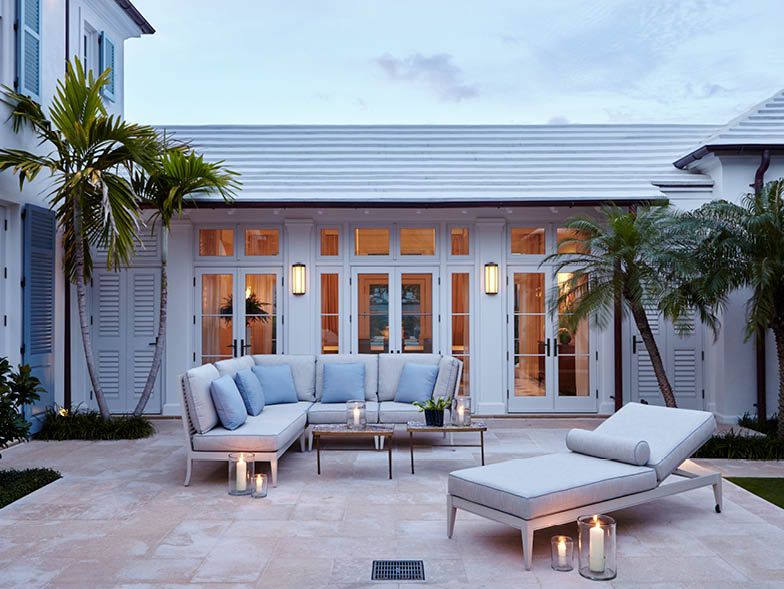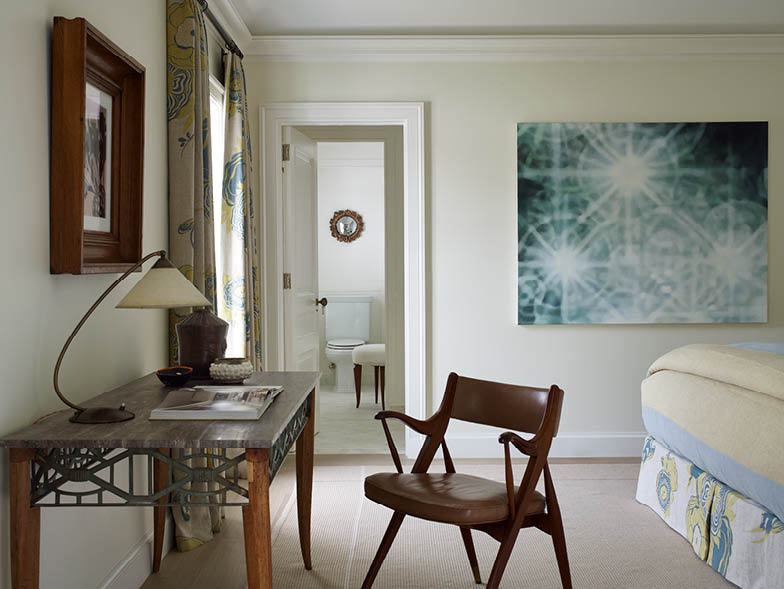
New York-based designer Charlie Ferrer has a way of tailoring a home to a person’s needs, while also leaving behind his signature mark: clean lines and eclecticism. Ferrer’s Palm Beach, Florida, project is no different. It encompasses everything that makes up a Floridian home with flair—art, ocean blues, and a breathtaking courtyard.
Where did you grow up?
Greenwich, Connecticut. Growing up in that area produced a sensitivity to beauty in the various manifestations of design—landscapes and gardens, interiors and decorative arts, and architecture. My mother curated my family’s homes, and her execution was thoughtful and practical. That style of living is, in many ways, the lifestyle I live today.

Where are you currently based?
New York City primarily, with a new outpost in London. My years in New York have been the most formative of my life. The city showed me the deeply passionate and collaborative spirit of the industry. But London is the next horizon for me. I spent a great deal of time in Europe sourcing material and seeking inspiration, as well as for pleasure. To produce work there has always been a goal.
Did you study design in school?
I majored in visual studies at the University of Pennsylvania. Penn was a challenge for me, and it took me a couple years to find my footing. A mélange of interdisciplinary coursework taught me how to “look” critically—how to articulate my thoughts and ideas around visual culture. My senior thesis investigated the relationship between hospital environments and patient outcomes. I argued that better design makes for improved health. I see this correlation in the residential setting, too, where great design inspires the mind and moves the heart toward a higher happiness quotient.
You previously worked in the furniture business in Los Angeles. How did that lead to you being in design?
My foray into furniture in LA launched me into the nuanced world of custom fabrication. I was very green going in, but I quickly learned about materials and finish, as well as the rare skills required to achieve excellence in the making of things. At that time, I learned mostly by trial and error. I have so much respect for historical furniture, and, because of my time there, I know what is required to design and execute a space successfully.

Tell us more about the Palm Beach project—which was your first interior project and also a home your parents had bought:
The architecture is Georgian—a classical vocabulary interpreted through a modern lens. I pared back ornamentation on both the exterior and interior to achieve a sense of timelessness and stately calm. I mixed contemporary art with vintage furniture and lighting—making it both eclectic and serene. The interiors shift the narrative forward in time, surveying a range of twentieth-century origins and styles.
What did your parents envision for this space?
My parents wanted a home that was light, open, and had outdoor rooms. I reacted by creating a restrained yet comfortable home designed for their style of living. It encompasses gardens, architecture, furniture, and art. They accompanied me on buying trips to Europe, numerous fairs, and auctions. It was a process of discovery, in which each step informed the next.
What was a source of inspiration for this project?
The supremely refined work of Jean-Michel Frank was a primary inspiration. I adopted and replicated several of Frank’s patterns, including the fabrics on the pair of living room sofas and the master bedroom rug. At the same time, the geographical context of the project informed the palette—ocean blues, sandy creams, and neutrals.

Would you expand on how the environment surrounding the home influences the overall aesthetic?
The palette and axial courtyard plan were designed to conjure the feelings of the beach, the sky, and the water, and to create views and layered perspectives within the site itself. To this end, there are almost no corridors. Rooms and gardens form passageways, which create easily permeable boundaries among spaces, both indoors and outdoors. Palm Beach light is intense at all hours. It’s sharp in the morning, radiant at midday, and glowing into the late afternoon and evening hours. I wanted the project to put one at ease and to make one understand the context of the house, with the ocean half a block away.
Do you have a favorite room or a favorite piece in the home?
The living room has to be my favorite. It is a vast, bright, and lofty room with courtyards on two sides. As far as specific pieces go, the pair of Ico Parisi armchairs covered in an ocean blue silk velvet are among my preferred in the project. They are gestural and nostalgic supportive forms, referencing train car seats.

How would you define your design style?
Balanced eclecticism is the thread that connects all of my work. Every home feels “collected” because it is the product of a considered edit of unique vintage pieces, custom items, and select contemporary works. I like to break conventions whenever appropriate, and I think this project illustrates this especially well.
You recently collaborated with the furniture store CB2 on its first vintage collection. What did you take away from the experience?
The conduit for the CB2 collaboration was Ross Cassidy—an LA-based friend and fellow designer. Ross had done several collaborations with CB2, and, when the subject of a vintage design collection was mentioned during a brainstorming meeting, he recommended they speak to me. The entirety of the process behind CB2 x FERRER is a wonderful example of the collaborative spirit of the design industry.
I learned that open-mindedness, resourcefulness, and hard work can bridge the massive regulatory differences between artisanal design and mass retailing. CB2 is a nimble, curious, and, ultimately, humanist company. Together, we realized and delivered a curated collection of vintage design to eighteen markets inside thirteen months. No other retailer has brought historical design to the market at this scale.

Do you have a favorite item in this collection?
Yes, the faceted desk and coffee table by Guglielmo Ulrich. These two pieces appeal to me for their great scale, architectural stature, and bold geometries. I am drawn to furniture that is highly specific without being overly designed—and the desk and table embody both qualities.
Have you found that social media influences your work?
Being observant impacts the breadth and quality of one’s practice. Moving through galleries, museums, and shops exposes one to new ideas and ways of seeing. Instagram, in many ways, enables this virtually, so it does tend to be a source of inspiration for me.
How have your travels inspired you—both in the spaces you design and in your collaboration with CB2?
Travel is inspiration and access. Practically speaking, it allows me to source historical design material for my clients and for my inventory. Traveling also exposes me to all manners of inspiration that invariably find their way into my work. Rather than reflect the trends broadcasted by media outlets, I prefer to draw inspiration from the past and interpretations of the past; my travels facilitate this.
What is a piece of advice that has really impacted you?
To take creative risks. Bold choices are better than safe ones.
For more info, visit ferrer.co



